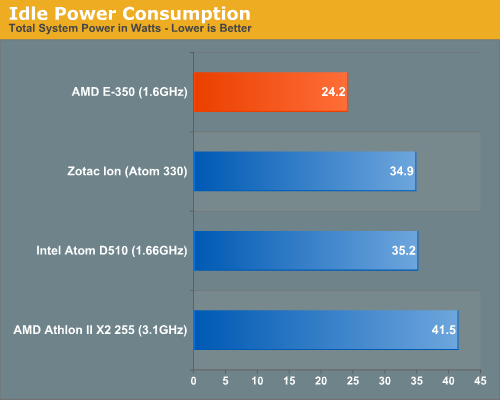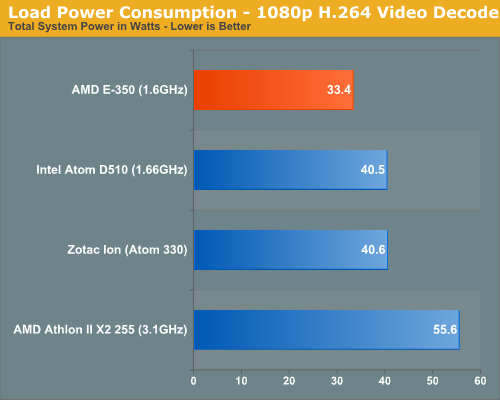The Brazos Review: AMD's E-350 Supplants ION for mini-ITX
by Anand Lal Shimpi on January 27, 2011 6:08 PM ESTPower Consumption: Better than Atom
Power efficiency was a big draw of Atom, but does AMD sacrifice any of that in order to deliver the performance it does with the E-350? To be blunt: no, not at all.
I don’t have any pico PSUs or anything super efficient readily available so don’t expect any of the numbers to be particularly impressive, but what they are is comparable to one another. I hooked up each one of the systems I’d been using to the same PSU and measured power in three conditions: idle, full CPU load (Cinebench 11.5) and while playing a 1080p H.264 video.

Pine Trail and the old ION platform consume just about the same amount of power at idle. The Athlon II system obviously draws more, in this case an increase of 17%. The E-350 uses less than 70% of the power of the Atom D510 system at idle.

Under load the Brazos advantage shrinks a bit but it’s still much lower power than Atom. While playing a H.264 you’re looking at ~83% of the power of an ION system, and 85% under full CPU load.

Say what you will about Intel’s manufacturing process advantage, it’s simply not put to use here with Atom. AMD’s E-350 is higher performing and uses less power than Intel’s 45nm Atom D510. Did I mention it’s built on a smaller die as well?
I wanted to isolate the CP...err APU and look at its power draw exclusively. I ran the same three tests but this time I’m not measuring power at the wall, but rather just power over the ATX12V connector directly to the CPU.
At idle the E-350 APU only requires around 3W of power. That’s actually not as low as I’d expect, especially given that Sandy Bridge is typically down at 4W when fully idle. AMD is apparently not being too aggressive with stopping clocks and gating when fully idle, at least on the desktop Brazos parts.
| Power Consumption Comparison | |||||
| ATX12V Power Draw | Idle | 1080p H.264 Decode | Cinebench 11.5 | ||
| AMD E-350 | 3W | 8W | 9W | ||
| AMD Athlon II X2 255 | 7W | 12W | 47W | ||
Under load, either full CPU or when using the video decode engine, APU power consumption is around 8 - 9W. By comparison, an Athlon II X2 255 will use 12W when decoding video (this doesn’t include the UVD engine in the 890GX doing most of the heavy lifting. The more interesting comparison is what happens when the CPU cores are fully loaded. The E-350 uses 9W running Cinebench 11.5 compared to 47W by the Athlon II X2.










176 Comments
View All Comments
DanaG - Friday, January 28, 2011 - link
One thing I'm wondering: how does Brazos compare to Atom and ARM (such as QNAP TS-219P+) on power usage and network performance? From reviews of ARM devices, it looks like they hit a speed limit that may be caused by the SoC devices themselves.I do know that Realtek Gigabit Ethernet sucks, so it'd be worthwhile to benchmark with an Intel NIC and a Broadcom NIC, as well.
Aone - Friday, January 28, 2011 - link
I reckon Anand Lal Shimpi should know that neither Atom D510 nor Atom 330 supports EIST or Idle Power State. If he does compare the power consumtion he, at least, must mention it.And i'm not sure that Atom platform supports DDR3-1333 as Brazos. Usually Atom sticks with DDR2-667.
Unfortunately, mem config is absent from description of test configs.
DanNeely - Friday, January 28, 2011 - link
DDR3-800 based atoms launched a few months back; the performance difference vs their DDR2 siblings was negligible.krish123 - Friday, January 28, 2011 - link
Hi Anand,You are comparing the gaming performance of Core I5 2500K / higher clocked graphics with E350, but u should also show the power consumption/price difference on those parts. .. I feel ., kind of biased review, when you are trying to compare only the positive side of intel parts and not the negative side
I will wait for your review on Llano and bulldozer
Regards,
Kicha
7Enigma - Friday, January 28, 2011 - link
Did you even read the text or just look at the pretty graphs?The i5 is in there as a bracketing agent so that those of us with desktop systems can get a feel for the performance difference to these Atom/APU products. There was never a direct comparison drawn unless you ignore all the text and just stare at the pictures.
OneArmedScissorB - Friday, January 28, 2011 - link
Did you even read the pretty graphs? They were very nearly neck and neck in those comparisons. Why omit the most significant differentiation between the two?Sandy Bridge and Bobcat as HTPC platforms are more comparable than anything else. They are both at least "good enough" for general use, have similar IGP and video acceleration capabilities, and are both readily available in mini-ITX.
And yet, there's a 3.1 GHz Athlon II X2 with an 890GX board in the power results, likely full size ATX, in place of every single last one of the numerous mini-ITX platforms they could have just copied and pasted into the chart from past articles. Wtfbbq?!?
That was not just an oversight, but a very significant mistake that detracts from the usefulness of the entire article.
bjacobson - Saturday, January 29, 2011 - link
hm, that seems a bit of an overstatement. I don't really see how the 2500's are at all in the same market as this.code65536 - Friday, January 28, 2011 - link
I wonder, does Bobcat support hardware-assisted virtualization?silverblue - Friday, January 28, 2011 - link
I read that it does.macs - Friday, January 28, 2011 - link
Can someone test the power consumption of an i3 2100 on itx mobo? I suppose it will be quite close to brazos, at idle at least